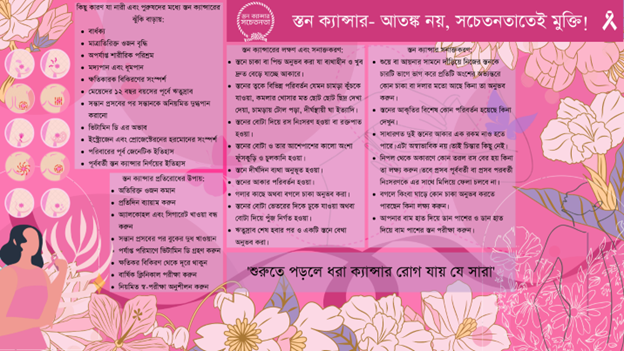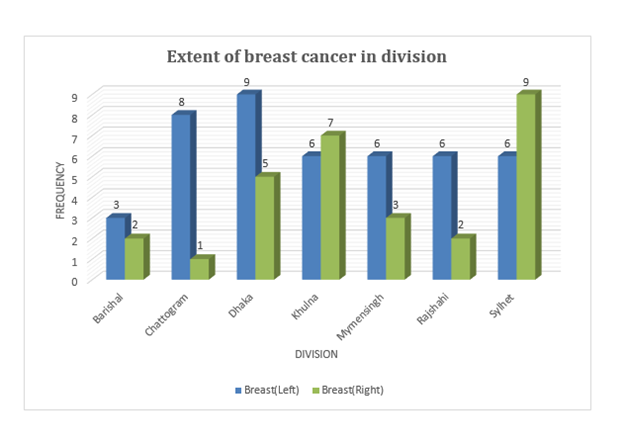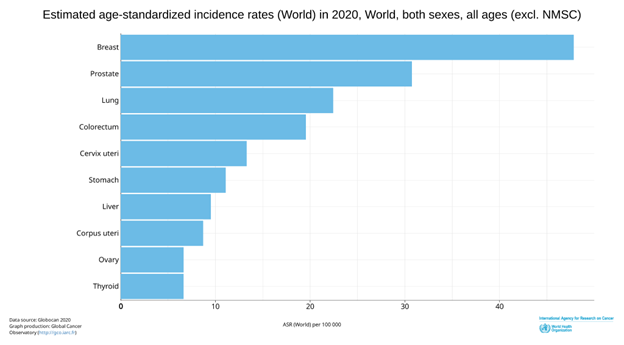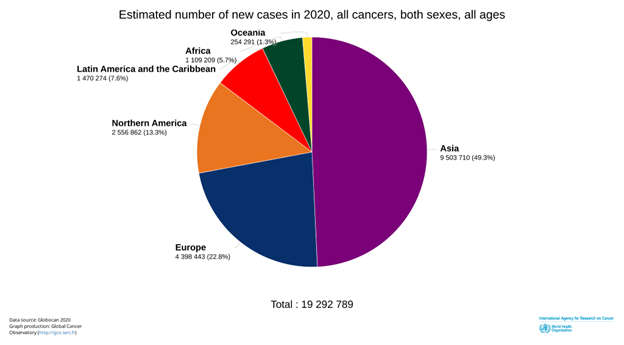Task: Creating a communication campaign plan on any social issue
Course Code and Name: MSJ11401 Development Communication
Project Name: Early Detection, Risk Reduction!
Project Date: Fall 2022
Project Type: Individual
Project Completed on Semester No: 09
CI Theme of the Term: Equal Opportunities in Science
Project Description:
The project titled “Early Detection, Risk Reduction!” is a development communication campaign aimed at creating awareness about breast cancer among the rural population of Kayetpara Union Parishad, Rupganj. This campaign was designed as part of the MSJ11401 Development Communication course during the Fall 2022 semester. The project focuses on educating rural women and their families about the importance of early detection of breast cancer, the risks associated with delayed diagnosis, and the necessary preventive measures. The campaign aimed to break the stigma surrounding breast cancer, promote early detection, and encourage preventive measures. Various communication tools and strategies were employed, including interpersonal, group, public, and mass communication, to effectively reach and educate the target audience.
Project Justification:
Breast cancer poses a significant health challenge in Bangladesh, especially in rural areas where awareness and education are limited. Many cases remain undiagnosed or untreated due to a lack of awareness and socio-cultural barriers. In rural communities like Kayetpara Union Parishad, women face additional obstacles such as restricted access to healthcare, lower educational levels, and economic constraints, which contribute to delayed detection and treatment of breast cancer.
This development communication campaign is essential to address these challenges. By raising awareness and promoting early detection practices, the campaign aims to overcome the barriers that prevent timely diagnosis and treatment. Involving multiple stakeholders—including local health workers, community leaders, and media outlets—will help create a supportive environment that encourages women to seek medical advice promptly and reduces the stigma associated with breast cancer. The project’s justification lies in its focus on a rural community with significant socio-economic and educational challenges, aiming to empower women through essential knowledge and early detection practices to combat the rising incidence of breast cancer effectively.

DEPARTMENT OF MEDIA STUDIES AND JOURNALISM
Course Name: Development Communication
Course Code: MSJ11401
Term: Fall 2022
Section: 02
MIDTERM Assignment (Individual)
Developing A Development Communication Campaign Plan to Create Awareness About the Increased Level of Breast Cancer Among the Public of Kayetpara Union Parishad, Rupganj
Submitted To
Dilshad Hossain Dodul
Senior Lecturer
Bachelor of Social Science,
Department of Media Studies and Journalism (MSJ)
University of Liberal Arts Bangladesh (ULAB)
Submitted By
Zakia Sultana Sanam
ID: 201012045
Date of Submission: 16th November, 2022.
EARLY DETECTION, RISK REDUCTION!
DEVELOPMENT COMMUNICATION CAMPAIGN:
The use of communication to promote social development is referred to as development communication. To achieve good social change through sustainable development, development communication involves stakeholders and decision-makers, creates favorable conditions, evaluates risks and possibilities, and fosters information exchange. Information sharing and education, behavior modification, social marketing, community involvement, media advocacy, and communication for social change are all examples of development communication approaches.
A development communication campaign is a planned initiative carried out within a particular target group with the goal of disseminating knowledge, attracting attention to and interest in the message, and bringing about change. Communication for development has five essential concepts: discourse, stakeholders, information exchange, and understanding one another. A communication-based development strategy can expose people’s underlying attitudes and conventional wisdom, assist people in changing their perspectives and gaining new information and skills, and disseminate social messages to sizable audiences.
Thus, it can be claimed that development communication plays two main roles, namely (a) transformative role, as it works to bring about social changes for a higher quality of life. (b) Playing a socializing role by trying to uphold some of the societal norms. It focuses on the use of both verbal and nonverbal cues to convey meaning across a range of media platforms and circumstances.
INTRODUCTION:
According to researchers, dealing with breast cancer in Bangladesh is an arduous job due to the lack of a central database, mass awareness among people, sociocultural and family traditions, poor economic conditions, illiteracy, etc. As per International Agency for Research on Cancer (IARC), every year more than 13,000 women in Bangladesh are infected with breast cancer and over 7,000 die. In recent years the number of patients in Bangladesh has been rapidly increasing though awareness has increased slightly. Due to shyness and other sociocultural and domestic reasons, most women go to doctors late. As a result, the disease enters a second or third stage and treatment costs increase a lot. So, much awareness is a must and we will do an awareness campaign so that people can detect the disease by themselves and minimize the treatment cost.
COMMUNITY:
A community is a group of individuals who reside within a particular region of broader society and share common interests or characteristics. It is a social unit that shares factors like geography, traditions, beliefs, values, or identity. Through communication platforms, communities can connect virtually or in a specific geographic location. For this development communication campaign for raising awareness on breast cancer, the chosen community is rural women as they get low health, education, and financial facilities.
TARGET AUDIENCES:
Target audiences are groups of people who share certain traits; these traits can be related to demographics, geography, occupation, affiliation with the organization, or past behaviors. For this development communication campaign for raising awareness of breast cancer, the chosen target audiences are rural women and their families. We are targeting them because their income is low hence, they tend to neglect health problems. Another reason is that most of them are illiterate or under-educated. They don’t know how to respond to this kind of health issue.
STAKEHOLDERS:
A stakeholder is a person or organization that has an interest in or is directly or indirectly impacted by a development project’s operations. The regular exchange of information between the project’s organizers and its stakeholders is referred to as stakeholder communication. Communication with stakeholders is crucial to ensuring that they understand the process, gaining their support for the project on a social, commercial, and political level, luring informed decisions, and reducing risks identified.
As we are doing our awareness campaign on breast cancer in the rural area named Kayetpara, our primary stakeholders will be the young girls (15+) and women of that area. For this development communication campaign, we need to make them aware of the self and early detection. Hence the cost and treatment complicacy will be reduced significantly.
Our secondary stakeholders will be the families of the women and targeted girls more than 15 years old. We will inform the families that they can teach their daughters about early detection. In this process, the next generations will be aware of breast cancer. Also, they will be able to detect early symptoms of breast cancer, if any of their family members or relatives suffers from it.
Our third type of stakeholders will be the social, health, and religious workers around the Kayetpara Union Parishad. We will choose school teachers, imams, temple priests, local NGO workers, and Union Parishad health workers for the awareness campaign. We will teach them the details of breast cancer so that they can raise awareness among the people of that union’s school, college, madrasa, temple, and health complex. Also, they can convey messages during prime occasions like school/college general assembly, Jumma khutbah, and general vaccination day.
Our fourth type of stakeholders will be the officials of Kayetpara Union Parishad like the Chairman, Members, Panchayat Committee, etc. They all have a direct social impact on the village people. Also, they can raise awareness among the people on special occasions like World Breast Cancer Awareness Month, Independence Day, Victory Day, etc.
As our final stakeholders for the campaign, we will also involve well-known national figures including local MPs, actresses, musicians, and community radio hosts. It would be an effective communication tool since people are easily persuaded by their words and actions.
PLAN:
We are doing our campaign in Kayet Para union as the people in this area are not well educated and economically stable. Breast Cancer is referred to as a type of stigma in rural areas, therefore we will try to break the taboo for women safety. As most women are housewives and do not go outside, they feel shy to express their health issues. We will try to convince these women to express their issues to their families. Also, we will try to convince the families that the women are the assets for them as they give child birth and breastfeed the child. So, their wellness is a top priority. Also, we will teach the women and girls how to detect breast cancer easily so that they can test on their house without going anywhere.
Our campaign is to increase awareness among the local people about breast cancer. So, we will try to inform and make people aware of breast cancer. The increasing use of pesticides in the agriculture industry is one of the main reasons behind breast cancer. As Kayetpara people mainly depend on the agriculture industry, we will try to make them aware of this issue. We will try to convince the local people that equal educational opportunities and economic freedom for women are necessary for effective breast cancer prevention. Also, after a breast cancer diagnosis, many patients in Bangladesh lose their status in the family. They are being harassed socially and economically. We will convey this message that these patients need more social support. We will try to manage the social leaders of that area to provide adequate resources and treatment facilities for them.
TYPES OF COMMUNICATION TOOLS WE ARE USING FOR THE CAMPAIGN:
- Poster
- Banner
- Billboard
- Leaflet/Flyer
- Social Media awareness Post
- YouTube awareness Video Content
- Television awareness advertisement
- Infographics
- Meeting/Assembly/Panel discussion/Webinar/Seminar
TYPES OF COMMUNICATION WE ARE USING FOR THE CAMPAIGN:
The concept of communication has always been ambiguous. Different scholars have defined communication from different perspectives. Generally, communication is a social process of sharing common ideas, thoughts, and feelings or exchanging meaningful information through mutually understood symbols like words, pictures, figures, and graphs between two or more individuals. For this specific campaign, we will be using these four types of communication listed below.
- Interpersonal Communication
- Group Communication
- Public Communication
- Mass Communication
- INTERPERSONAL COMMUNICATION:
Interpersonal communication is the verbal or nonverbal exchange of information, ideas, and feelings between two or more individuals. Interpersonal communication, however, is when two people talk to each other or convey information. Through this medium, understandable communication between the sender and the receiver is formed. The domain of interpersonal communication studies how people communicate with one another in social, personal, and everyday circumstances.
- Stakeholders for Interpersonal Communication:
For this type of communication, we will use primary and secondary stakeholders. Our primary stakeholders are girls (15+) and women of that area. Our secondary stakeholders will be the families and parents of the females.
- Explanation of the Plan:
By way of Interpersonal Communication, we will talk to the women, girls and their family members individually. We will let them know the procedure of early detection and prevention mechanisms. We will talk with the husbands and convey them that they should support their wives and act responsibly with breast cancer patients. As a fact, the patients who experience more social support and manage their relationships better report healthier outcomes. We will talk to the parents of girls and let them know the breast cancer details and tell them that they should be more concerned on this issue. Also, we will ask them to ensure equal educational opportunities and economic freedom for women to reduce the risk of breast cancer.
- GROUP COMMUNICATION:
Group communication is defined as communication that occurs between three or more individuals who work together to achieve a common objective through the sharing of ideas or expressions. It is the act of sending and receiving messages to multiple members in a group. Interdependent individuals examine data, assess the nature of the issue, make a choice, and offer a potential course of action during small group discussion. Group communication, however, also affects how members of the group interact with and perceive one another.
- Stakeholders for Interpersonal Communication:
For this type of communication, we will communicate to the school teachers, imams, temple priests, local NGO workers, and Union Parishad health workers for the awareness campaign.
- Explanation of the Plan:
We will talk to the group of teachers and we will share the breast cancer do’s and don’ts with them. As they are the most impactful person to the students, parents and whole society they can play a vital role by raising awareness among them. We will also brief the breast cancer details to the mosque imams and temple priests and ask them to convey it to the people after religious prayers. We will also use local NGO workers as they go to the people’s house to help them on different issues. Union Parishad health workers who worked for different health campaigns can raise awareness among the people too.
- PUBLIC COMMUNICATION:
Public communication is the act of conveying a message or information to a community or group of people through a notable individual, public figure, procession member, or public representative. It is a type of strategic communication that is employed when an individual or group of individuals collect and disseminate information to an audience in order to convey a message about a specific issue. It is an essential kind of communication and is typically done with a particular goal in mind.
- Stakeholders for Interpersonal Communication:
Stakeholders in public communication will be Kayetpara Union Parishad officials such as the chairman, members, panchayat committee, etc. They all directly affect the villagers’ standard of living. On significant occasions like World Breast Cancer Awareness Month, Independence Day, Victory Day, etc., they can also inform the public.
- Explanation of the Plan:
A big number of people in this area will be motivated together through public communication. We would include Kayetpara Union Parishad authorities from the chairman to the members to the panchayat committee in our campaign. For the locals there, they will deliver a speech about awareness. Discuss issues including women’s health, education, and the dangers of breast cancer. Health precautions to avoid breast cancer will be made known to females and their families. These individuals are socially prominent leaders in that region. If people pay attention to them, individuals will be able to trust them and be concerned about the deadly breast cancer. Therefore, we can raise awareness of breast cancer and prevent it through public communication.
- MASS COMMUNICATION:
Mass communication is the process of importing, creating, transmitting, and receiving, exchanging, and analyzing information to large segments of a diverse and anonymous population. The several platforms that make up these media include radio, television, print, social media, digital and internet media, and more. It significantly affects the number of persons who are influenced. It is a vast field that considers both the methods used to make a communication and the target audience. It is often assumed that its technologies link to a variety of media because they are used to transmit information, of which journalism and advertising are a part.
- Stakeholders for Interpersonal Communication:
In the process of mass communication, we will take help from the local Radio Station, local TV-Channel, local Newspaper, Facebook Influencer, Actors, Musicians, Star Players, and Local MP as stakeholders.
- Explanation of the Plan:
Since mass communication can reach a large number of people, we will use the local radio station for this process of communication. Locals are in charge of managing community radios, which mostly provide content concerning the local population. As a result, we will promote breast cancer awareness by using community radio, emphasizing the early causes, identification, symptoms, and prevention. Additionally, we will host TVCs featuring prominent actors, athletes, and musicians. Actors, musicians, and other famous personalities will promote the message about breast cancer awareness in a 2- to 3-minute TV commercial. Additionally, we will hold public announcements across the region with the assistance of a local Kayetpara MP. Every hospital, public-private building, school, and intersection will have posters or banners promoting breast cancer prevention. To raise women’s awareness of breast cancer prevention, we will promote a variety of video content and animation videos on television and social media. because individuals can be influenced and made aware by watching these videos.
CONCLUSION:
By combining the aforementioned communication strategies, we can create an effective campaign to raise awareness of the rising incidence of breast cancer both in the city’s urban and rural areas. Our goal is to properly inform individuals about the disease and provide them with useful advice for a healthier life.
POSTER:

STATISTICAL DATA:



Learnings and Outcomes (Self-reflection):
- Understood the strength of strategic communication in advocating societal change.
- Learned to use diverse communication methodologies for targeted impact.
- Appreciated the importance of engaging multiple stakeholders for effective campaigns.
- Enhanced problem-solving skills in addressing a pressing social issue.
- Gained insights into the challenges of health communication in rural settings.
- Developed a comprehensive approach to campaign planning and execution.